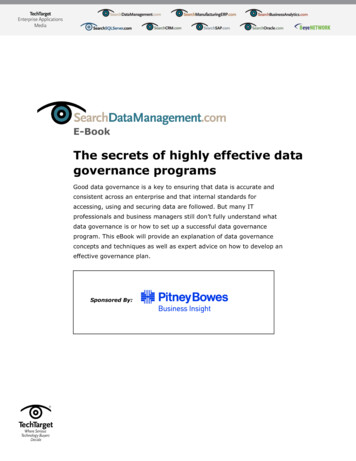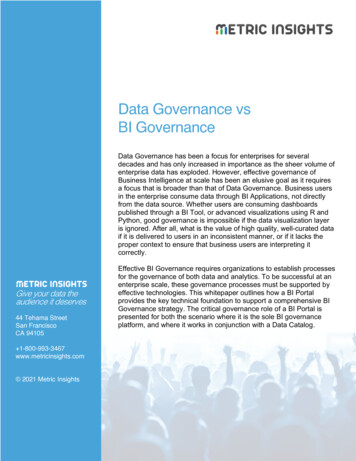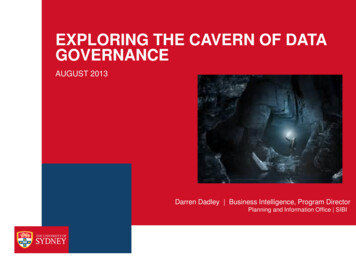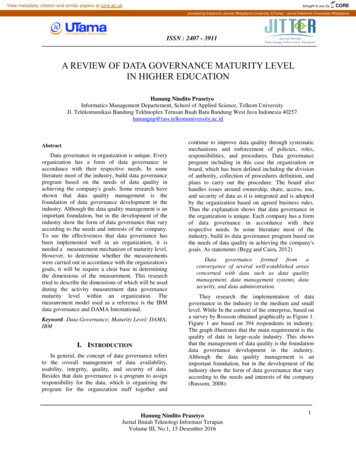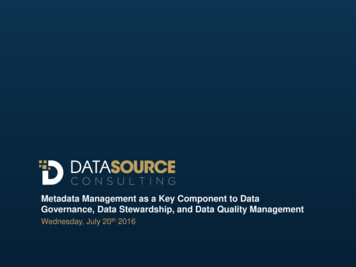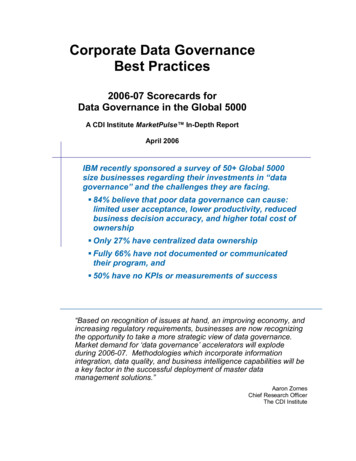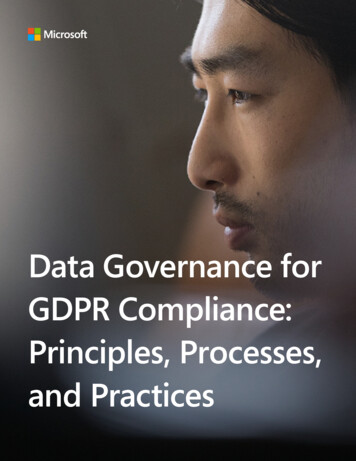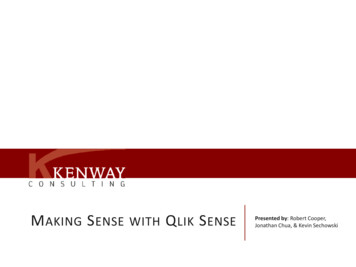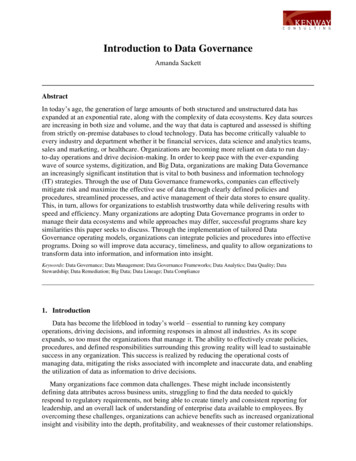
Transcription
Introduction to Data GovernanceAmanda SackettAbstractIn today’s age, the generation of large amounts of both structured and unstructured data hasexpanded at an exponential rate, along with the complexity of data ecosystems. Key data sourcesare increasing in both size and volume, and the way that data is captured and assessed is shiftingfrom strictly on-premise databases to cloud technology. Data has become critically valuable toevery industry and department whether it be financial services, data science and analytics teams,sales and marketing, or healthcare. Organizations are becoming more reliant on data to run dayto-day operations and drive decision-making. In order to keep pace with the ever-expandingwave of source systems, digitization, and Big Data, organizations are making Data Governancean increasingly significant institution that is vital to both business and information technology(IT) strategies. Through the use of Data Governance frameworks, companies can effectivelymitigate risk and maximize the effective use of data through clearly defined policies andprocedures, streamlined processes, and active management of their data stores to ensure quality.This, in turn, allows for organizations to establish trustworthy data while delivering results withspeed and efficiency. Many organizations are adopting Data Governance programs in order tomanage their data ecosystems and while approaches may differ, successful programs share keysimilarities this paper seeks to discuss. Through the implementation of tailored DataGovernance operating models, organizations can integrate policies and procedures into effectiveprograms. Doing so will improve data accuracy, timeliness, and quality to allow organizations totransform data into information, and information into insight.Keywords: Data Governance; Data Management; Data Governance Frameworks; Data Analytics; Data Quality; DataStewardship; Data Remediation; Big Data; Data Lineage; Data Compliance1. IntroductionData has become the lifeblood in today’s world – essential to running key companyoperations, driving decisions, and informing responses in almost all industries. As its scopeexpands, so too must the organizations that manage it. The ability to effectively create policies,procedures, and defined responsibilities surrounding this growing reality will lead to sustainablesuccess in any organization. This success is realized by reducing the operational costs ofmanaging data, mitigating the risks associated with incomplete and inaccurate data, and enablingthe utilization of data as information to drive decisions.Many organizations face common data challenges. These might include inconsistentlydefining data attributes across business units, struggling to find the data needed to quicklyrespond to regulatory requirements, not being able to create timely and consistent reporting forleadership, and an overall lack of understanding of enterprise data available to employees. Byovercoming these challenges, organizations can achieve benefits such as increased organizationalinsight and visibility into the depth, profitability, and weaknesses of their customer relationships.
To address these common challenges, organizations must adopt a Data Governance program,which is the formal orchestration of people, processes, and technology to enable an organizationto leverage its data as an enterprise asset. By proactively governing their data, organizations andindustries are better able to achieve their strategies and objectives by decreasing the costs ofmanaging data and increasing their ability to capitalize data as an asset. While there arevariations of Data Governance frameworks, there are three universal pillars: policies andstandards, processes, and roles and responsibilities.When beginning to face the challenges presented by a lack of Data Governance, it isimportant to understand the fundamental difference between Data Governance and DataManagement. These two terms are often interchanged when addressing data strategy but, whilethe two are interconnected, they are not the same. Data Governance is the high-level oversight ofdata providing the policies and procedures required to deliver complete, accurate, consistent, andtimely data. Data Management1, on the other hand, is the day-to-day execution of DataGovernance policies, and includes the processes people follow as well as the tools andtechnologies they need to help them comply with the mandates of the Data Governance program.Data Management cannot succeed without Data Governance, which is why high-qualityimplementation of a Data Governance program is crucial to any long-term success. As thevolume and complexity of data increases, so does the gap in Data Management capabilities whenthere is a continued absence of Data Governance. A Data Governance program should enforcethe integration of strategy, standards, policies, and communication to deliver optimally.Regardless of the size of an organization’s data scope, preparedness is crucial to ensure thequality delivery of data. This paper will explore the key cornerstones of any Data Governanceprogram, the relevance of these programs, and the key advantages of implementing an effectiveData Governance program into any organization.“As the volume and complexity of data increases exponentially, so does the gap in Data Managementcapabilities with the continued absence of Data Governance.”2. Discussion2.1.Motivations & Use Cases for Data GovernanceData is now a pervasive and mandatory aspect in any organization; thus, the importance ofleadership in its understanding and investment cannot be downplayed. High-quality data is anasset which can be utilized to achieve a multitude of goals. Proper governance and managementof data will ensure accuracy. This will not only manage risks but allow organizations totransform opportunities into advantages. By integrating Data Governance into an organization’scorporate structure, organizations can increase trust in their data, improve efficiency to betterutilize resources, and provide futureproofing to allow for the introduction of innovativetechnologies and data tools that will enhance data utilization.An organization needs to know what it is investing in, how much the investment costs,and the value it brings, along with other metrics that drive decision-making. By having strongData Governance policies and procedures, enterprise data tied to strategic initiatives can be1Data Management is the administrative process by which data is acquired, validated, stored, protectedand processed to ensure accessibility, reliability, and timeliness of data.
effectively utilized to measure risk and returns while still controlling other costs. Highly accuratedata will also lead to meaningful insight through clarity of reporting and analytics which willguide organizations to maximize profit. By eliminating errors from incorrect data, reducingduplicative work for data feeds/stores, and reducing manual reconciliation or data manipulation,Data Governance will help to minimize costs by reducing the amount of effort needed incorrecting and maintaining data stores. Overall, Data Governance will eliminate the need forhaving to divert internal resources to these tasks or having to hire outside of the organization tohandle data cleanup.One example of how Data Governance can help to work toward achieving these goals is bydefining data policies that standardize key data attributes for greater data consistency andunderstanding across an organization. If an organization does not have standardized definitionsfor its data elements, data becomes convoluted and processes become inefficient. For somethingsuch as inventory management, having a standardized definition across the organization iscrucial to ensuring product inventory is both complete and accurate, and that there are metricsavailable around sales, usage, age, etc. Ensuring this accuracy will allow for precise strategicplanning and portfolio management downstream. Through data consistency, an organization canreduce cost and increase operational effectiveness by automating data reporting while informingstrategic planning.Another potential outcome of employing an effective Data Governance program isimproved customer satisfaction resulting from data procedures and clean data. Today, peoplewant clear visualizations of data that are digestible, and delivered quickly and regularly. In thehealthcare industry, for example, this might come in the form of patient experience (PX)dashboards to display health facility and provider performance statistics along with various PXmetrics that will inform on improvement of care.A Data Governance program can also empower the creation of business dashboards inorder to gauge opportunity streams or customer profitabilityprofiles. This is done by leveraging consolidated data from acrossthe organization which helps to recognize pain points as well asidentify opportunity pipelines. To achieve this, an organization’sdata structures must be seamless across platforms to allow the datato be linked. Having clear policies and procedures in place willmake an organization’s data easy to manipulate and leverage intoconsolidated reporting and analytics platforms to provide up-to-datereporting. This will increase organizational capacity, alleviating theneed for data cleanup and allowing an organization to effectivelyutilize data visualization and maximize understanding of its data.This provides insight on organizational direction, performance, andprofits, which ultimately will inform downstream decision-making.In addition to facilitating quality data visualization, whichbroadens the scope of data understanding, Data Governance alsoallows for the consolidation of a user’s experiences. As data andsystems expand and merge, bringing data together across systemsbecomes challenging. Data Governance programs supportstandardization across these systems which allows for a moreseamless user experience. With technology platforms like webportals and applications becoming more relevant, a consolidated User Experience/Customer
Experience (UX/CX) will improve overall experience and efficacy. Whether this is mergingmultiple login systems to work under one centralized hub or improving customer support andrelationship managers (RMs), Data Governance can streamline messy systems and help with themarketing sales interactions. The evidence and motivation toward implementing a DataGovernance program is overwhelming. Getting started in implementing these programs can be adaunting task; however, the first step is choosing a framework that will guide how policies arecreated, procedures are implemented, and how the structure of the teams that will lead theprogram are determined.2.2.The Data Governance FrameworksOnce an organization decides to begin implementing a Data Governance program, it isimportant for it to define the scope of its data and to choose the right framework that meets itsneeds. This will determine how successful both the implementation and ongoing maintenance ofthe program will be. An organization must minimize data risk and create effectivecountermeasures against potential threats, while maximizing the benefits from data usage.Setting objectives and goals is the first measure to ensure a Data Governance program will meetthe requirements for organizational success. Once policies are created and the procedures are inmotion, there must be a team that will effectively manage and maintain those rules postimplementation. The structure of this team will vary based on an organization’s unique structureand needs. There are a few approaches to resourcing a Data Governance program; however, thereis no right answer that works best. In a case study examining two comparable telemarketingfirms2, each firm chose differing frameworks and configurations of Data Governance based onfactors unique to the organization, including goals and structure. While different approacheswere taken, both firms had successful Data Governance programs, demonstrating there is no“one size fits all” solution when it comes to Data Governance frameworks.There are three common frameworks that are utilized when executing a Data Governanceprogram (Figure 1). The first is the highly centralized approach. This involves fully allocatedresources whose sole role responsibility is the Data Governance program. This approach istypically seen in large organizations or those with complex governance and data issues thatnecessitates a team fully dedicated to managing data policies. The next framework is thedecentralized (or federated) approach, which involves partially allocated resources with no fullyallocated resources existing solely for Data Governance. Instead, resources have DataGovernance roles alongside other job responsibilities. This approach is typically seen in smallerorganizations or those in the infancy of a Data Governance initiative. The last framework is thehybrid approach. This approach involves a mix of fully allocated and partially allocatedresources in which some resources are fully dedicated to managing the program while others arepartially allocated to the program alongside other responsibilities. The typical arrangement forthis method is for the Data Governance Office to be instantiated with fully dedicated resourceswhile a Steering Committee and Working Group are comprised of partially dedicated resources.As stated before, the approach selected by an organization will be dependent on anorganization’s unique attributes and needs.The framework that has been selected will inform the roles that must be assigned to carryout the various responsibilities. Defining these roles and responsibilities is a critical aspect that2Otto, Boris. Organizing Data Governance: Findings from the Telecommunications Industry and Consequences forLarge Service Providers. Communications of the Association for Information Systems. Volume 29, August article 3610&context cais
will ensure the smooth running of any program. Core roles and groups include executivesponsors and stakeholders, a Steering Committee, an Office of Data Governance, a WorkingGroup, data stewards, data creators, and data consumers.In each of the frameworks, the data creators, stewards, and consumers will lay down thegroundwork and maintain the underlying data for an organization. First, data creators will enteror extract data into/from a source system. The data stewards will then ensure the quality of thatdata by performing data review and cleansing activities. These individuals will serve as liaisonsto business units regarding governance policy and procedure items, consolidation of systems,data consumers and originators, and IT support. The final aspect behind the data in anorganization will be the data consumers who utilize the data for both operational systems, tasks,and analytics. As the data flows downstream, systems and employees will use this data forprocess support and organizational engagement.While the data teams are critical, executive sponsorship and stakeholder buy-in arecrucial for the success of any Data Governance program. These are the individuals whounderstand corporate strategies and working with them will ensure the program is built to alignwith these strategies. This will guarantee that stakeholders remain committed to the program andunderstand its overall business importance. The most common reason for failure in DataGovernance initiatives is a lack of executive sponsorship. These sponsors are typicallyorganization leads who will ensure funding and resources are available to execute the DataGovernance program.These players roll up into three governing bodies that oversee an organization’s DataGovernance program. The first is the Steering Committee, which is the core leadership for theData Governance initiative. This committee will approve funding, budget, and resourceallocation for strategic data projects. It also will ensure that there is alignment with corporateobjectives and define the overall road map and priorities. The Steering Committee must be readyto assist in enforcement to guarantee that all individuals responsible for Data Governanceactivities are held accountable, while also looking inward to ensure its own adherence.The next governing body is the Data Governance Working Group, which oversees the executionof the Data Governance program and much of the day-to-day data quality management. Itprovides the guidance and enforcement to drive change in the use and maintenance of data.
These individuals will mainly focus on Data Governance execution through training, education,and promoting awareness to the organization’s employees. This group will also serve as keystakeholders in the definition and implementation of policies and procedures.Finally, there is the Office of Data Governance, which is comprised of chair membersfrom both the Steering Committee and Data Governance Working Group. This office handles theoverall management of Data Governance and will define the standards, metrics, and proceduresfor data quality across the organization and advise business and technical resources on datastandards to ensure data quality. This group serves as the front line to all impacted partiesaffected by the deployment of a new data policy.2.3.Implementing Data GovernanceAfter a framework is chosen and roles and responsibilities have been defined, theimplementation of a Data Governance program can begin. The first step in developing a DataGovernance program is to establish Data Governance policies that will govern and act as thebackbone of the program. The policies will function as an internal regulation mechanism, onewith which organizations must comply to effectively ensure they have the right resources,structure, and enforcement within their programs. When setting a Data Governance policy,organizations must first look inward to determine the current state of their corporate strategies.For example, they might ask what role their information plays in decision-making as they assesstheir performance against corporate strategies. With that in mind, existing data structures must beanalyzed to determine where the pitfalls are in the current system that would hinderorganizations from achieving their strategic goals, and what would need to change to enable theirsuccess. This frame of mind will help mold the creation of a policy specific to an organization’sneeds. By creating policies, the organization is creating a rulebook and statements defining howdata will be managed and what its Data Governance program will entail.Policies will be created at both the organizational and data element levels. Theorganizational-level policies, sometimes referred to as “anchor policies,” address the overarchingrules and structures with which organizations must comply. These rules lay the groundwork forhow an organization will effectively manage its Data Governance, and how they apply to theorganization as a whole. They also will set the stage for the overall program within anorganization. The organizational-level policies might be setting a rule that simply states anorganization will have a formalized Data Governance program and define the organizationalframework, membership, authority, charter, and other such infrastructure elements to which itwill adhere. Additional organizational-level policies might lay out the foundation for datapractices including mandates for the creation and maintenance of data dictionaries for allcompany data including related metadata, lineage, and data quality rules. This kind of policy willdefine part of the work that the Data Governance program needs to support.Lower-level data policies will cover the governing of the actual data and data elements.While anchor policies will set the rules of engagement surrounding Data Governance, the dataelement policies will work downstream to improve the quality, accuracy, completeness, andconsistency of data. This is where the real change occurs. An example of this type of policymight include rules governing the appropriate use of a key field such as a status field. A policygoverning status may provide guidance on appropriate values (i.e., quality, accuracy), whether tomake the field required (i.e., completeness), and that these values be leveraged across all systemsthat use a status field (i.e., consistency). This policy, when set, will act as the rulebook by which
subsequent procedures and processes are executed. By laying down this foundation, it willestablish the basis on which the remainder of the program and procedures rely. Without a policyin place, there is no structure or driving force behind any future actions, which can lead to thefailure of a Data Governance program.“While there are variations of Data Governance frameworks, there are three universal pillars:policies and standards, processes, and roles and responsibilities.”As policies for a Data Governance program are finalized, an organization must then layout the procedures to implement that policy or correct existing procedures that are counter to thenewly created policy. For example, a Data Governance policy might require all new customerrecords have a unique identifier (e.g., Tax ID) populated with nine numeric digits. From there,procedures to certify this policy is followed could include data entry, exception reviews,duplication management, and any others needed across all systems in which the concept ofcustomer originates and/or is used. The Data Governance organization would lead the creation oftechnical tools (e.g., front-end entry screens, required fields, drop-down lists) as well as resourceresponsibilities (e.g., weekly data reviews, training, communication) to efficiently execute saidprocedures. This execution and enforcement of policies is critical for ensuring trustworthy data.While technology is a valuable tool, policies resulting in training, Change Management, andcommunication are also viable (and often cost-effective) tactics that should be implemented.Another important practice that should underlie any program is data quality reporting toprove that the Data Governance program is successful and useful. By periodically measuringdata quality from the start of the Data Governance Program, organizations can provide insightsKey metrics and key performance indicators (KPIs) for Data Governance programs3 are:Program PerformanceData QualityBusiness Value Number of supported groupsand users Issue Metrics: Number of issues,resolution time, issue status Qualitative engagement scores Data Steward KPI: Number ofitems for review, resolution time Record error / review requiredalerts Duplicate record check, orphanrecord alerts Data Integrity Metrics: Recordcompleteness, field uniqueness,data consistency, and dataconnection density Regulatory compliance status Risk mitigation (i.e., costs avoided) Cost Savings: Resource time,software costs, maintenance costs Value Creation: Lift in cross-sell /up-sell revenue, customerretention, customer satisfaction,resource allocationFigure 2. Key metrics and key performance indicators will ensure a Data Governance program maximized program performance, data quality,and business valueinto how the program is improving data quality, as well as highlight areas that need moreimprovement. Procedures must also be put in place to account for issue management. Constantmonitoring and management of the program while intermittently making tactical fixes willensure the data retains the appropriate level of quality and consistency. These fixes might includeData Governance procedures such as creating data definitions, defining attributes, amendingattributes, and retiring attributes. Issue management will also entail revising the procedures sothat a Data Governance program continues to evolve to best meet the organization’s needs.3Karel, Rob. Monitoring Data with Data Monitoring Tools. Informatica Blog. 2 January w-to-data-andits-value/
Overall, a successful program will have policies and procedures working in tandem, with anorganized team that will implement and enforce the Data Governance program.Once an organization has chosen the Data Governance framework that will best suit itsneeds and initiated Data Governance deployment, it should then define the methods for ongoingmonitoring and maintenance of the program. As discussed above, adding accountability toresource roles and responsibilities is key to ensuring theownership and implementation of Data Governancepolicies. By doing this, it will guarantee proceduresbecome a part of day-to-day operations. Furthermore,actively monitoring the performance of the DataGovernance program both in terms of data qualityimprovements and the attainment of business values (e.g.,lower costs, operational efficiency, increased sales) iscritical to continually improving an organization’s DataGovernance operating model. Creating reporting assets,either through the purchase of a Data Governance tool orthrough an internal build, is one way to address thesemonitoring tasks. Analytics dashboards, scorecards, andstatus updates provide managers and operators withinsights into the overarching performance of a DataGovernance platform.It is of note that a large component of implementationis Change Management. There is a need to align bothpeople and processes to strategic initiatives. By applyingtenets of Change Management4, an organization canensure there is understanding and buy-in from bothstakeholders and all impacted resources which will aid inthe successful rollout of the program. By settingincremental goals and including team members who will be impacted by the new program, theorganization will build momentum within the program, allow for feedback and increasedparticipant buy-in, and create a sense of accountability in the successful rollout. As the processcontinues, there is a need for continuous evaluation to understand which components aresuccessful and which are not. Measures to gain stakeholder trust include setting successmeasures followed by evaluation, recommendations for improvement, and broadcasting success.This trust and collaboration are critical as stakeholders will be the ones to advocate for andexpand Data Governance programs throughout an organization. By utilizing ChangeManagement and broadcasting success, an organization can minimize risks associated withsignificant culture shifts and guarantee governance thrives instead of falling to the wayside.2.4.Data Governance Maturity CurveOverall, it is good practice to periodically assess the maturity of Data Governance in anorganization. Quantifying and defining scope and ability lets an organization assess the state ofits program, understand its data capabilities, identify vulnerabilities, and know which areas need4Best practices of Change Management include acknowledging underlying culture, leadershipcommitment, building change capability, constant communication, and transparency.
improvement. The level of maturity and complexity of an organization’s Data Governancemonitoring capability, as well as its overall Data Governance program, helps to identify where itfalls on the Data Governance Maturity Curve (Figure 3). When an organization’s DataGovernance maturity is at the Unaware stage, there are no policies or procedures in place toensure the enterprise-wide or even cross-functional quality of data. This often arises asorganizations grow, while early-stage organizations can afford to allow distinct groups andbusiness units to function separately. As the utilization of data across an organization increases,the organization moves to a higher level of maturity, the Aware stage, where there is some siloedData Governance to support its growing capabilities. These organizations typically requireindependent efforts to create consistent data. For example, a sales team may require its users toenter an email address for all prospects in order to tie customer interactions to orders. This wouldlikely require some manual reviews of records and addressing missing data on an ad-hoc basiswithout the appropriate Data Governance in place.As an organization begins to formalize Data Governance, it moves into the Defined &Managed stage of the Maturity Curve. Here, standards and policies (similar to the email addressexample above) are in place across the organization which allows for a more robust connectionof information across all systems. The formalization of these standards and policies requires thecreation of dedicated roles and responsibilities for Data Governance. As discussed, DataGovernance frameworks can vary by organization, but they each fundamentally involve a coregovernance team and ties to resources’ job descriptions. Finally, the organizations with the mostmature Data Governance optimize their existing operating framework to allow for theenhancements of strategic assets throughout the organization. These companies factor in DataGovernance as they deploy new services, product features, and incorporate new data sets. Thisallows them to quickly and efficiently integrate data into their current operations, minimizing thetime to value and costs to manage the data.
Wherever on the maturity spectrum an organization may be, understanding the changesrequired to reach the next step will be vital to successful implementation. As the complexity ofsystems increase and an organization progresses along the maturity curve, it will find that itneeds to address the shifting landscape of its organization which often comes in the form oforganizational change management. Whatever the method, as the organization evolves, it mustcontinue to optimize its processes to realize the highest level of benefits and remain competitiveon the market. By continuously assessing capability and utilizing a maturity curve, anorgani
similarities this paper seeks to discuss. Through the implementation of tailored Data Governance operating models, organizations can integrate policies and procedures into effective . Data Governance policies and procedures, enterprise data tied to strategic initiatives can be 1 Data Management is the administrative process by which data is .
